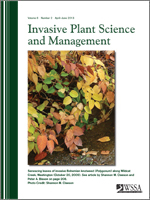Biochar, a carbon-rich product formed by the incomplete combustion of biomass, has been shown to improve soil quality and increase crop growth but has not been evaluated in prairie ecosystems. We assessed the response of a native perennial grass, big bluestem, and an invasive herbaceous perennial, sericea, to biochar amendments in two greenhouse experiments in 2010 and 2011. In the first experiment, big bluestem and sericea were grown in monoculture; the main treatments were soil type (silt, sand), percent biochar (0%, 1%, 2%, and 4%) and nitrogen (0 and 10 g N m−2). Big bluestem growth was increased by the addition of biochar, particularly in the sand soil. In contrast, sericea growth was either not affected or decreased when biochar was added to the soil, particularly at the higher biochar rates. Adding N to the soil appeared to increase sericea growth in the presence of biochar and the silt soil, which suggests that biochar may have reduced N availability. A replacement series was used in the second experiment to evaluate the effect of biochar on competition between the two species. Main treatments were biochar rates (0% and 2%), nitrogen rates (0 and 10 g N m−2) and the following big bluestem to sericea ratios: 6 ∶ 0, 4 ∶ 2, 3 ∶ 3, 2 ∶ 4, and 0 ∶ 6. After 180 d, big bluestem height and biomass were significantly greater in biochar-amended soils than in unamended soils. However, sericea height and biomass were unaffected by biochar amendments and the addition of biochar did not alter competitive outcomes. Competition between big bluestem and sericea was asymmetrical; sericea reduced the growth of big bluestem but big bluestem had relatively little effect on the growth of sericea. Our research suggests that biochar has the potential to increase the growth of big bluestem and may be a useful tool for prairie restoration.
Nomenclature: Big bluestem, Andropogon gerardii Vitman, sericea, Lespedeza cuneata (Dumont) G. Don.
Management Implications: Sericea is an important weed in prairie and grassland systems in North America. The use of biochar as a soil amendment has the potential to improve the growth of big bluestem and may limit sericea growth in some soils. However, our research suggests that sericea is much more competitive than big bluestem and that biochar amendments alone may not be sufficient to alter competitive outcomes between these two species.





